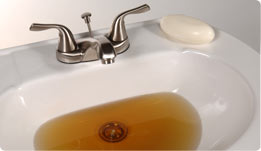|
What we need to know to quote you a solution to your well water
First you will need to get your water analyzed. If that is a problem then we can send you a water test kit for 29.95 which we will fully refund you for if you should purchase a system with us. Click HERE for the test kit.
There are three common things most people want addressed with their well water. Iron, hydrogen sulphide and hardness (calcium) The problem is that there is often more than one system needed. A standard softener can look after some of the problems if the levels are low. But then a reverse osmosis system is needed for drinking water. If you levels are higher than normal or there are other problems, two or three systems may be required to address the different problems. For this reason we need as much information about your water as possible as some contaminants can damage the media in the system. For example, if you were to purchase the 'No Salt Softener' and there is iron present in your water, the iron will eventually damage the media in the softener. Here is a list of some of the things we need to know to be able to suggest the ideal treatment system for your water;
Here are more things that would be helpful to know;
If your water is turning things dark red or black this is usually caused by either iron or manganese. Click HERE to learn about the difference between red and clear water iron and manganese. Forms of Iron Iron can occur in water in a number of different forms. The type of iron present is important when considering water treatment. Water that comes out of the faucet clear, but turns red or brown after standing is “ferrous” iron, commonly referred to as “ clear-water ” iron. Water which is red or yellow when first drawn is “ferrous iron (Fe +2 )” iron, often referred to as “red- water” iron. Iron can form compounds with naturally occurring acids, and exist as “ organic ” iron. Organic iron is usually yellow or brown, but may be colorless. Water containing iron bacteria is said to contain “ bacterial ” iron. Clear-water iron is most commonly removed with a water softener. Manufacturers report that some units are capable of removing up to 10 mg/L, however 2 to 5 mg/L is a more common limit. A water softener is actually designed to remove hardness minerals like calcium and magnesium. Iron will plug the softener, and must be periodically removed from the softener resin by backwashing. Also, if the water hardness is low and the iron content high, or if the water system allows contact with air, such as occurs in an air-charged “galvanized” pressure tank, a softener will not work well. Ion exchange water softeners add sodium to the water which may be a concern for persons on a sodium restricted diet. Click HERE for a solution for this. Red-water iron can reduced but not removed completely by a sediment filter, carbon filter, or water softener, but the treatment system will very quickly plug up. A more common treatment for red-water iron and clear-water iron in concentrations up to 10 or 15 mg/L is a manganese greensand filter, often referred to as an “iron filter.” Aeration (injecting air) or chemical oxidation (usually adding chlorine in the form of calcium or sodium hypochlorite) followed by filtration are options if iron levels exceed 10 mg/L. Click HERE for more info. Organic iron and tannins present special water treatment challenges. Tannins are natural organics produced by vegetation which stain water a tea-color. In fact, the tannins in coffee or tea produce the brown color. When tea or coffee is made with water containing iron, the tannins react with the iron forming a black residue. Organic iron is a compound formed from an organic acid and iron. Organic iron and tannins can occur in very shallow wells, or wells being affected by surface water. Organic iron and tannins can slow or prevent iron oxidation, so water softeners, aeration systems, and iron filters may not work well. Chemical oxidation such as Chlorination, followed by proper filtration equipment will remove the organic iron. Ckick HERE to see our Chlorination System. Iron bacteria are organisms that consume iron to survive and, in the process, produce deposits of iron, and a red or brown slime called a “biofilm.” The organisms are not harmful to humans, but can make an iron problem much worse. The organisms naturally occur in shallow soils and groundwater, and they may be introduced into a well or water system when it is constructed or repaired. Treatment options for elimination or reduction of iron bacteria include physical removal, heat, and chemical treatment. The most common treatment is “shock” chlorination of the well and water system. Remember, iron bacteria need iron to survive. Eliminating the bacteria will not eliminate the iron - both well treatment for the bacteria, and water treatment for the iron will be needed.
Testing Yellow or red colored water is often a good indication that iron is present. However, a testing laboratory can determine the exact amount of iron, which is required in determining the best type of treatment. In addition to testing for iron, it can be of value to also test for hardness, pH, alkalinity, and iron bacteria. County health departments may offer some of these tests. Private testing laboratories can be contacted about their services and fees. Most advertise in the phone book under “Laboratories-Testing.” The amount of a dissolved material in water is usually reported as the number of milligrams per liter (mg/L). This is the weight of material in 1 liter (approximately 1 quart) of water. A milligram per liter is approximately equal to 1 part per million (ppm). Iron in amounts above 0.3 mg/L is usually considered objectionable. Iron levels are usually less than 10 mg/L. Click HERE for treatment options.
Is there turbidity? ( Mud/silt/clay/sediment in water ) Silt is difficult to remove from the water and may require chemical injection to be removed. If you have consumers telling you they have silt in the water, advise them that a filter cartridge may not solve the problem. Is there iron bacteria? Check the back of the toilets for slim build up if the house has been existing for a period of time. If the house is new, a bacteria test will be required. |
Service site for BelKraft International - BelKraft Canada - Carico All Rights Reserved

